The Lifecycle of a Service
A presentation at DevOps Minneapolis Meetup in in Minneapolis, MN, USA by Matt Stratton

The Lifecycle of a Service Matt Stratton DevOps Advocate & Thought Validator, PagerDuty @mattstratton

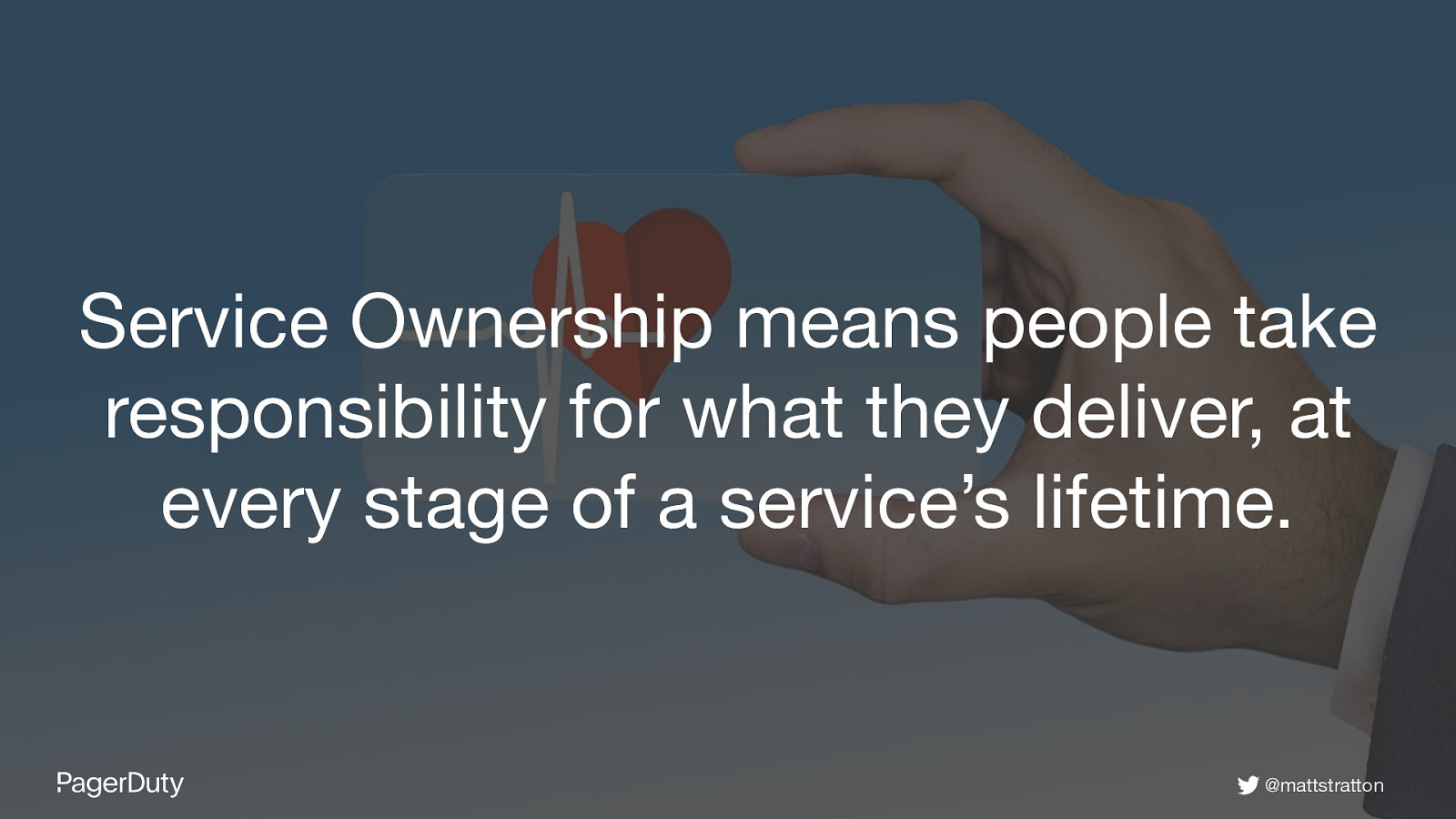
Service Ownership means people take responsibility for what they deliver, at every stage of a service’s lifetime. @mattstratton

Communicate across your organization with partners and stakeholders @mattstratton

What is a service? @mattstratton

A service can be a lot of things Microservice Slice of a monolith Internal tool Piece of functionality Component Shared infrastructure Feature @mattstratton
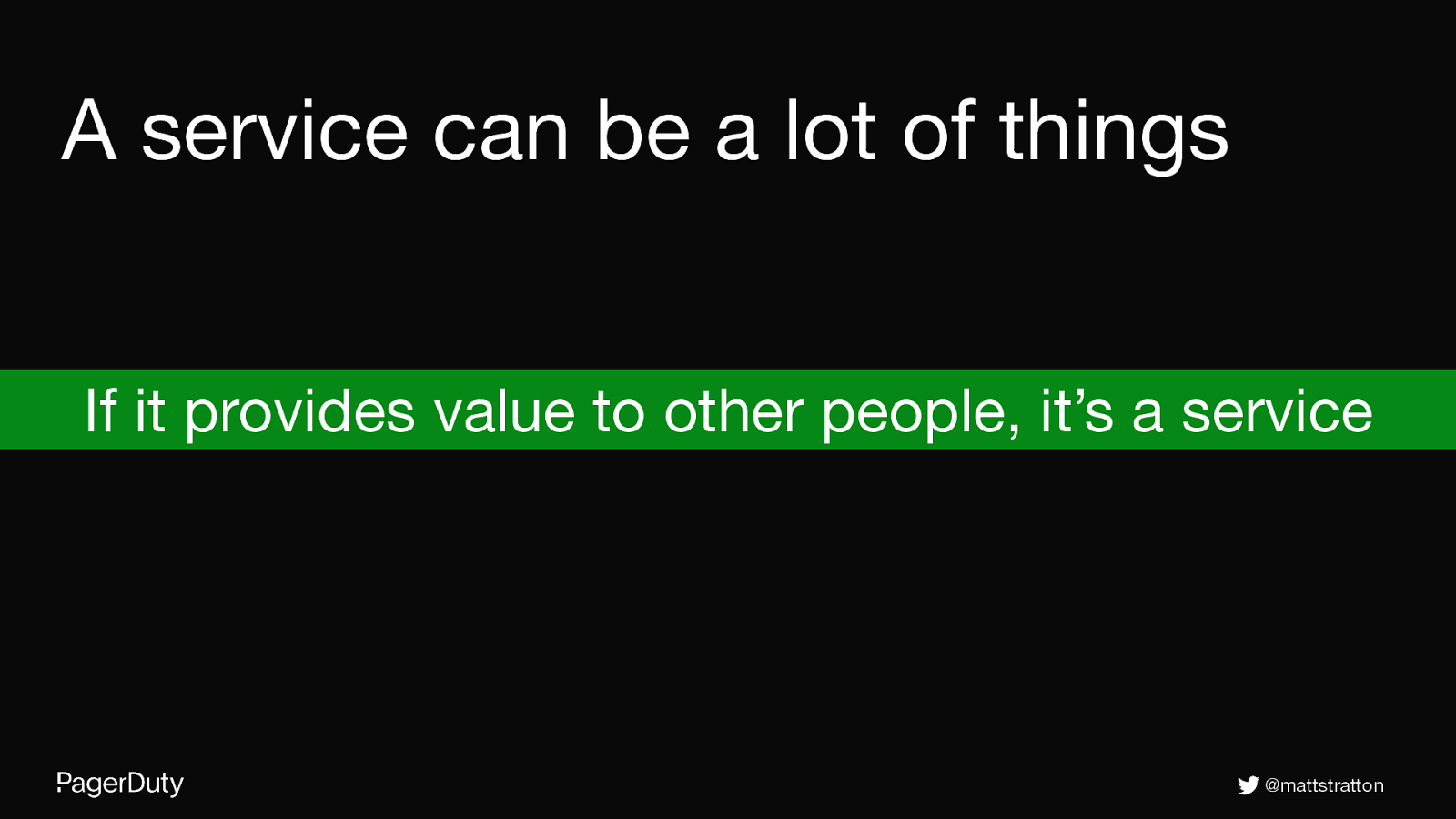
A service can be a lot of things If it provides value to other people, it’s a service @mattstratton
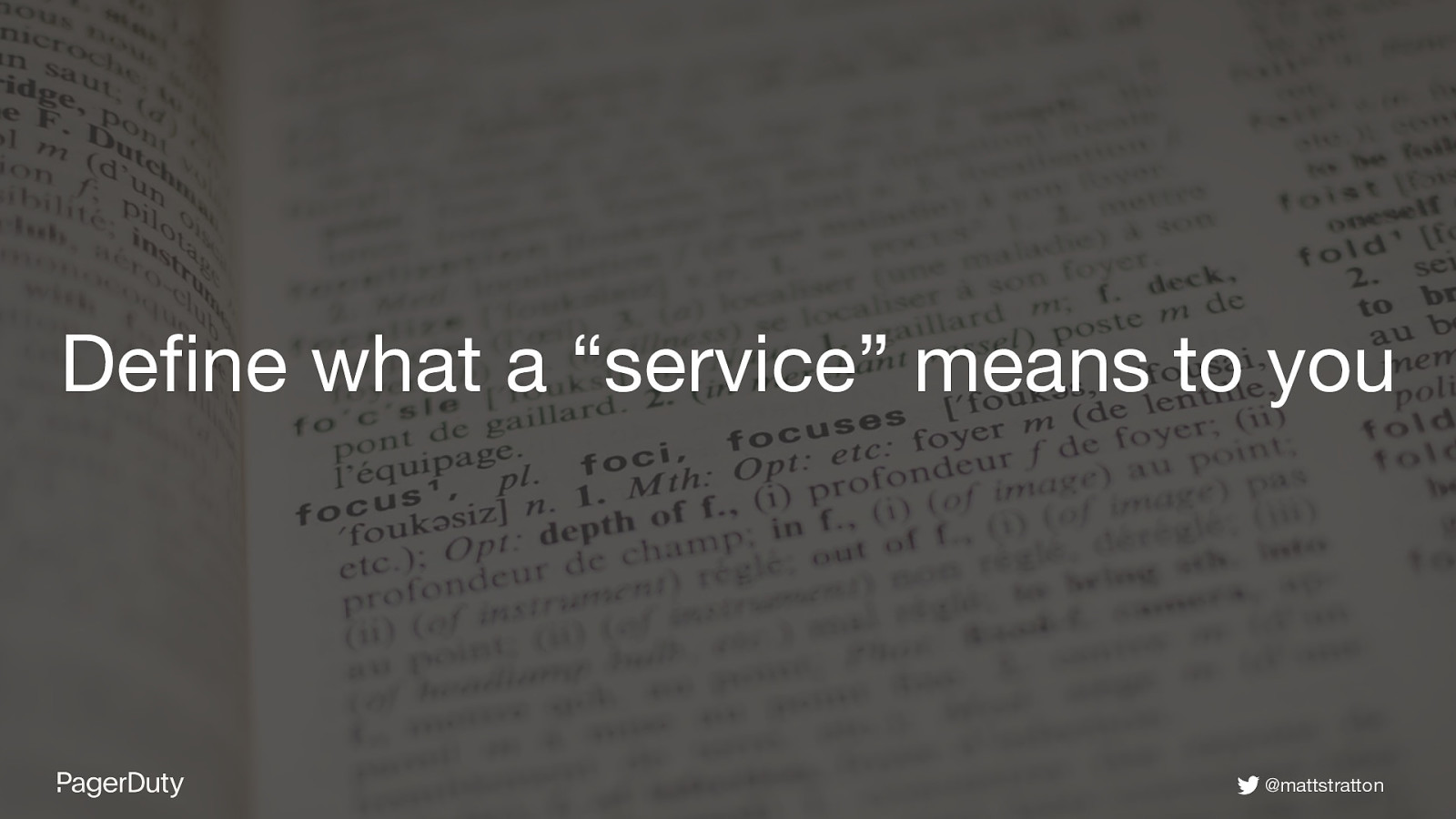
Define what a “service” means to you @mattstratton
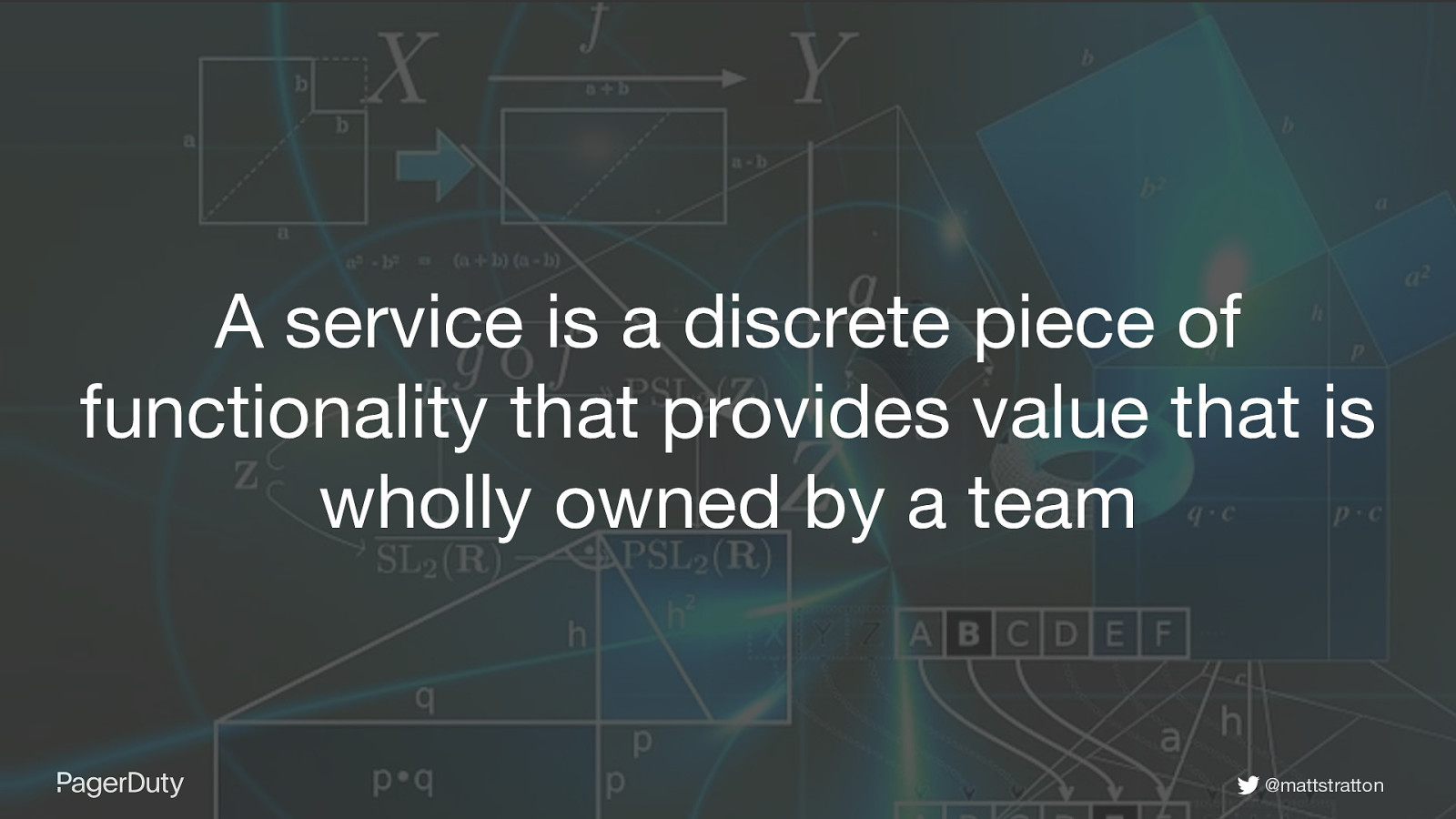
A service is a discrete piece of functionality that provides value that is wholly owned by a team @mattstratton

Shared understanding @mattstratton

Who is responsible? @mattstratton
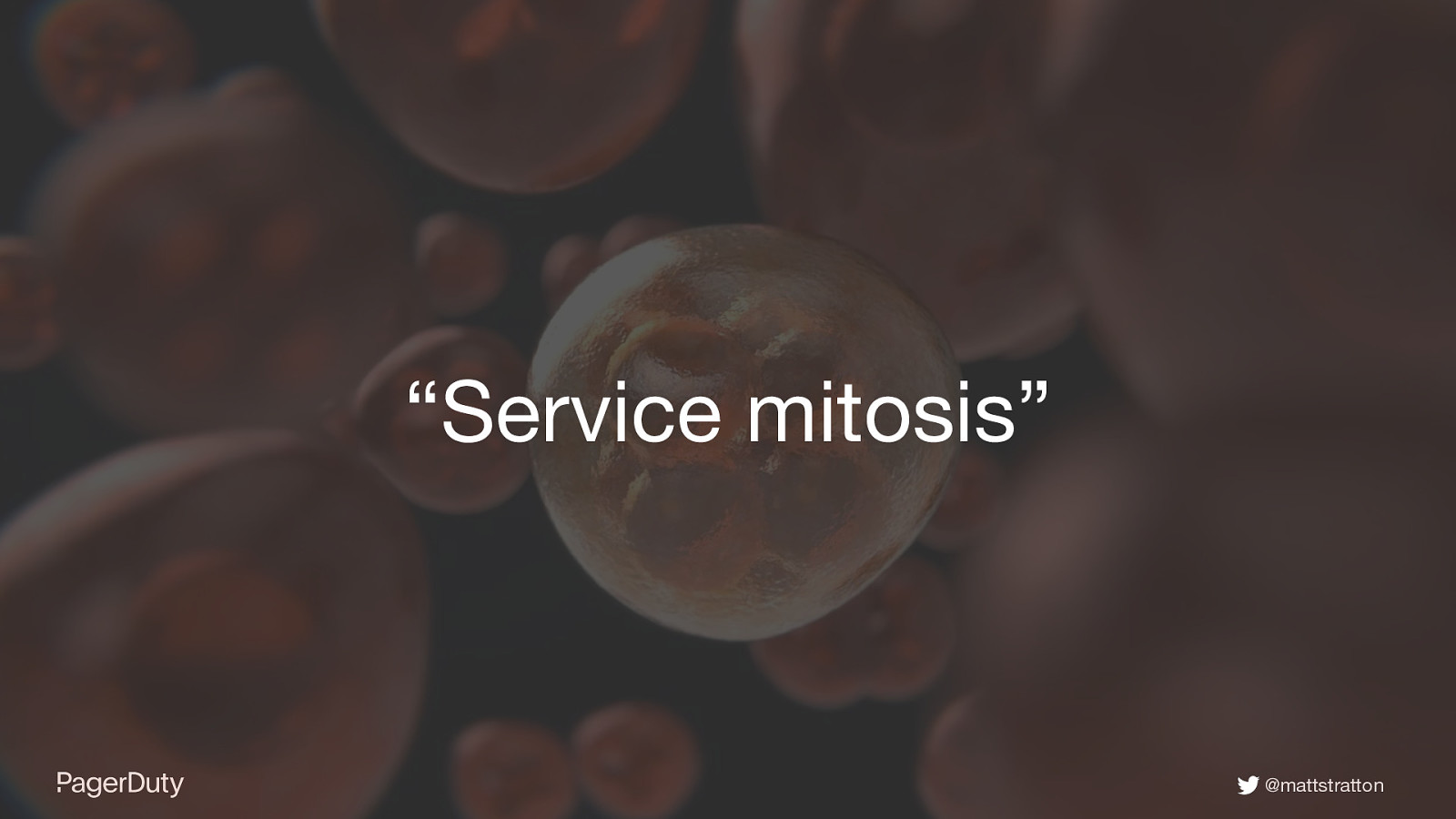
“Service mitosis” @mattstratton
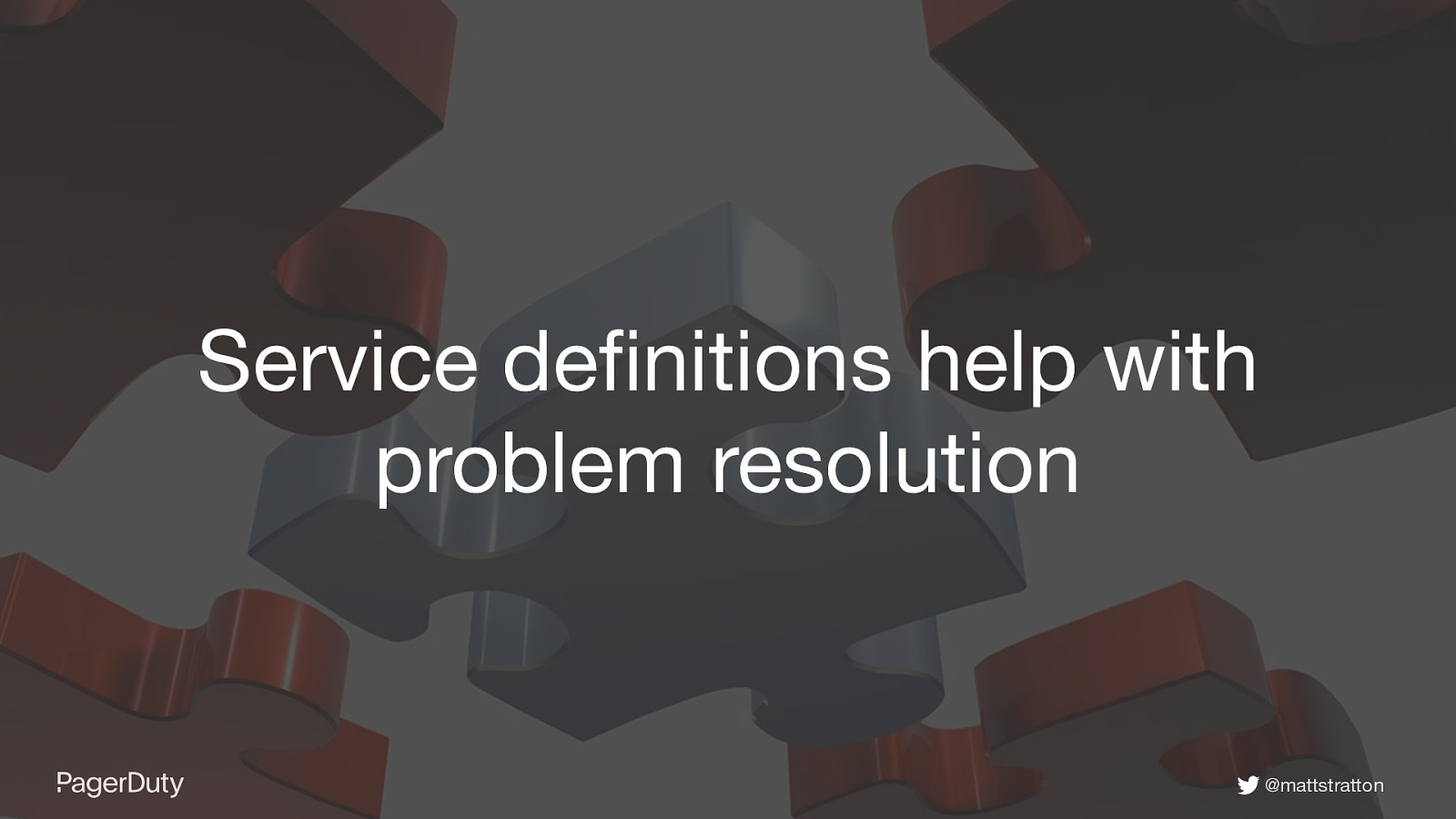
Service definitions help with problem resolution @mattstratton

What about a monolith? @mattstratton
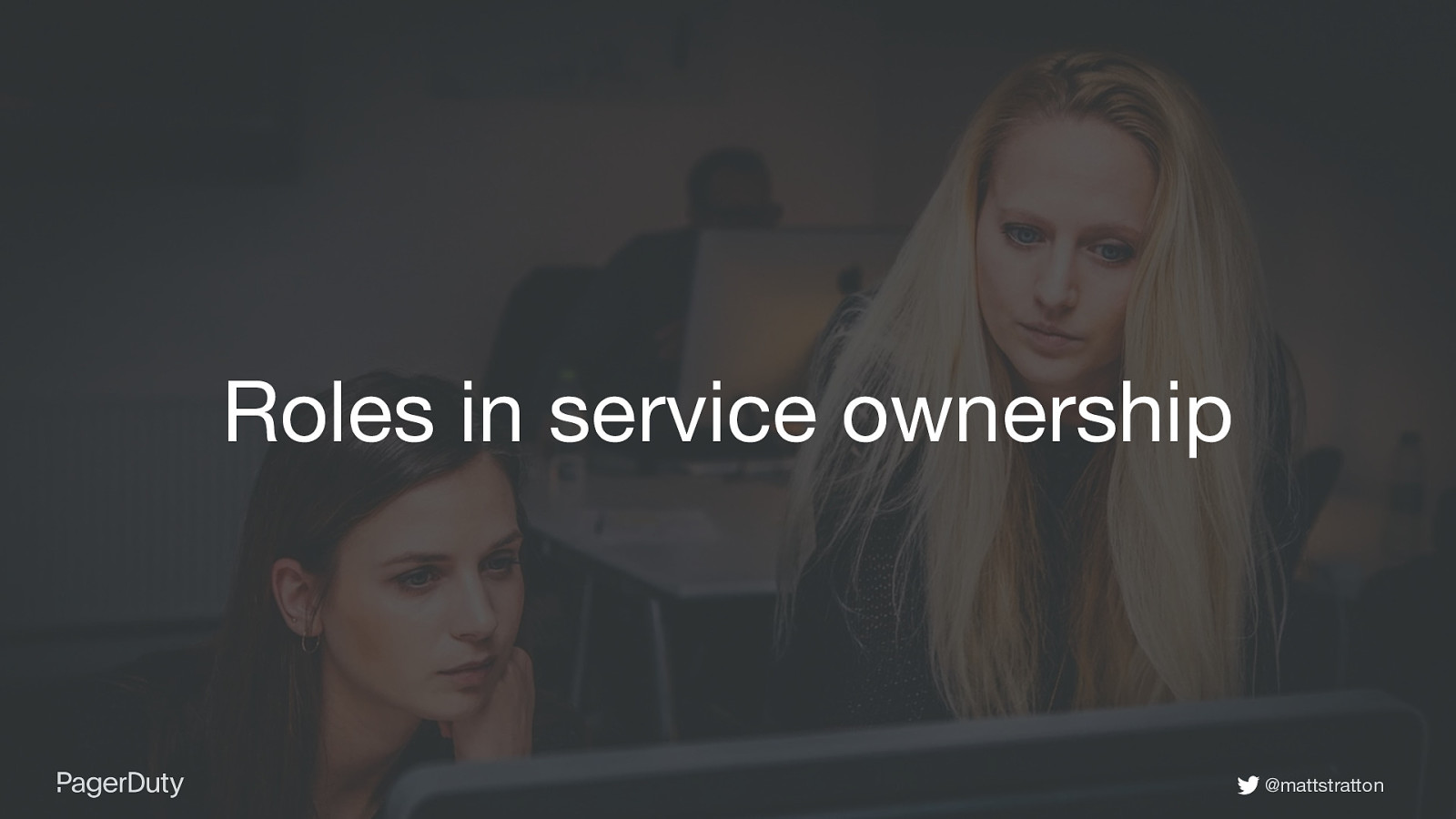
Roles in service ownership @mattstratton

Development Team @mattstratton

Your service should make sense to other people who will interact with it @mattstratton

Naming @mattstratton

Be specific @mattstratton

Names that are specific • “User authenticator” • “Payment processor” • “Shopping cart” • “Login” • “Report generator” • “Email tracking code” @mattstratton

Less amazing names • PacMan (unless you’re actually building PAC-MAN, which I doubt) • Apollo • BurgunDB • Artemis @mattstratton

Descriptions @mattstratton

• What is the intent of this service, component, this slice of functionality? • How does this thing deliver value? • What does it contribute to? • How will this impact customers? @mattstratton

Dependencies • Look for circular dependencies • Is there a single point of failure? • Who consumes this service? • What does it depend on? @mattstratton

API • Versioning • Clear documentation / examples @mattstratton
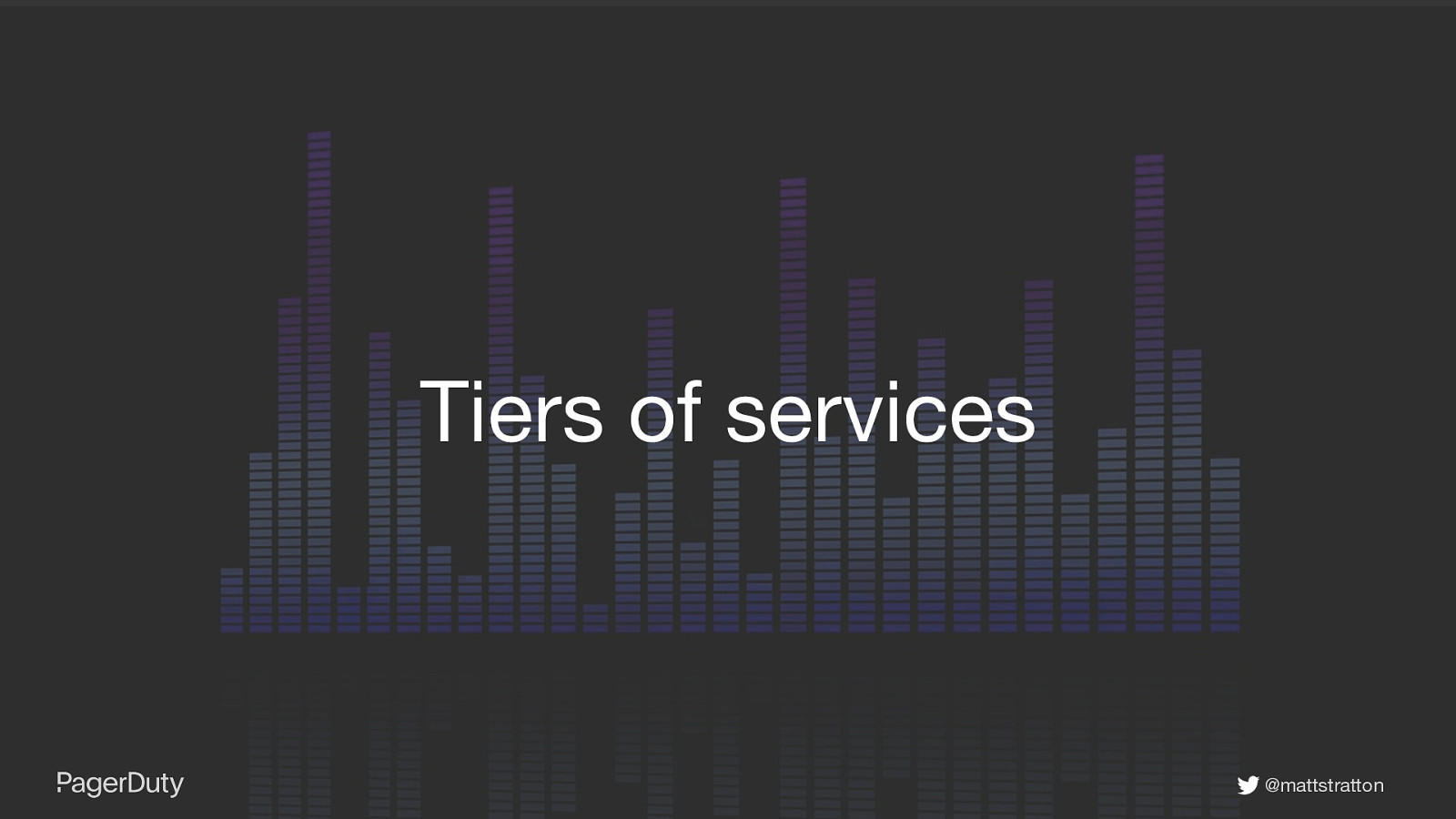
Tiers of services @mattstratton

Tier 1 Services at PagerDuty • 24/7 on-call • Multiple levels of robustness • Disaster recovery plan • Clear and updated runbook @mattstratton

Tier 2 & 3 Services at PagerDuty • Monday-Friday support expectation • Supporting functionality, not critical path • New services that are not generally available @mattstratton
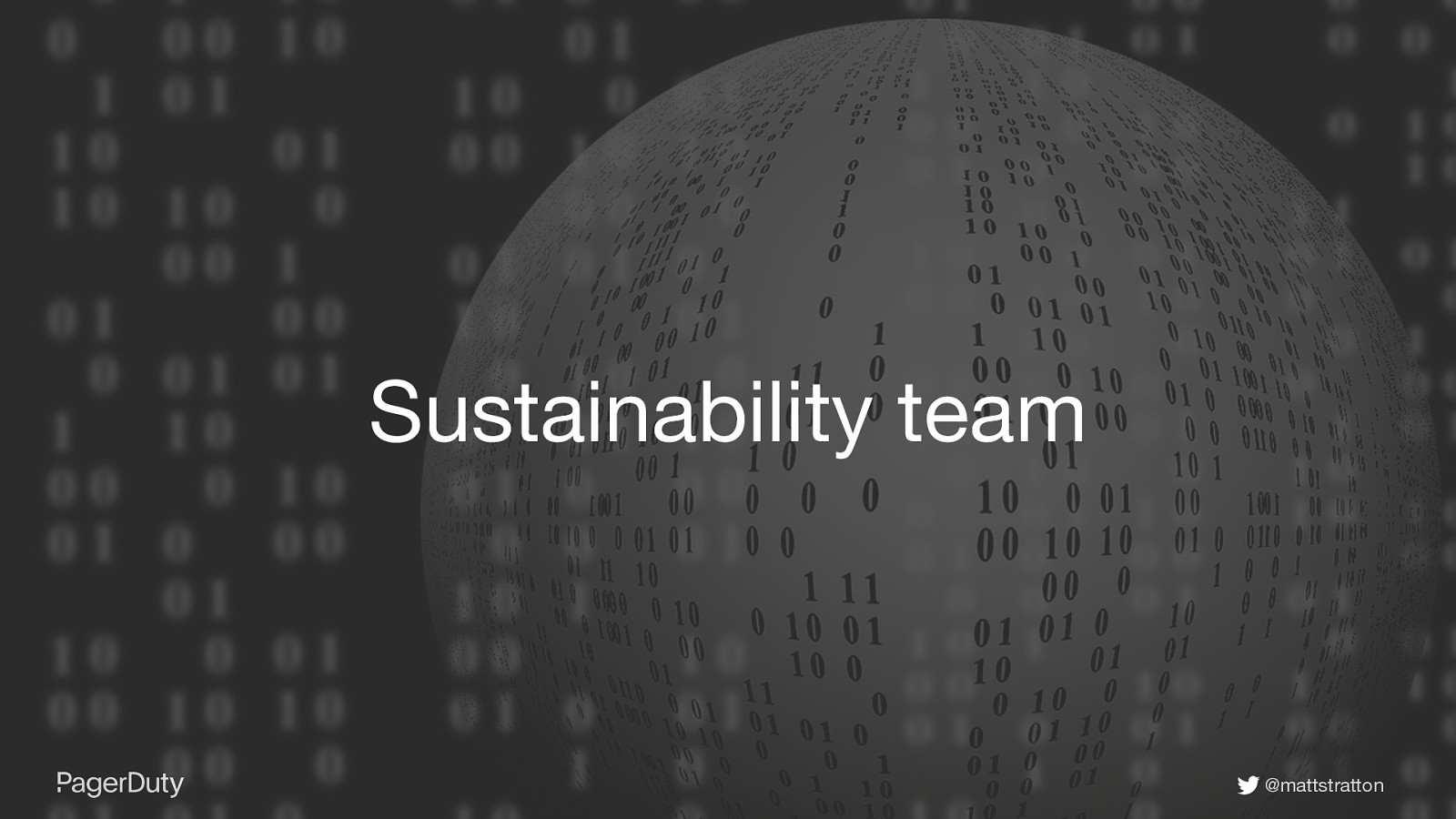
Sustainability team @mattstratton

Runbooks @mattstratton

Alerting @mattstratton

Robustness and reliability @mattstratton
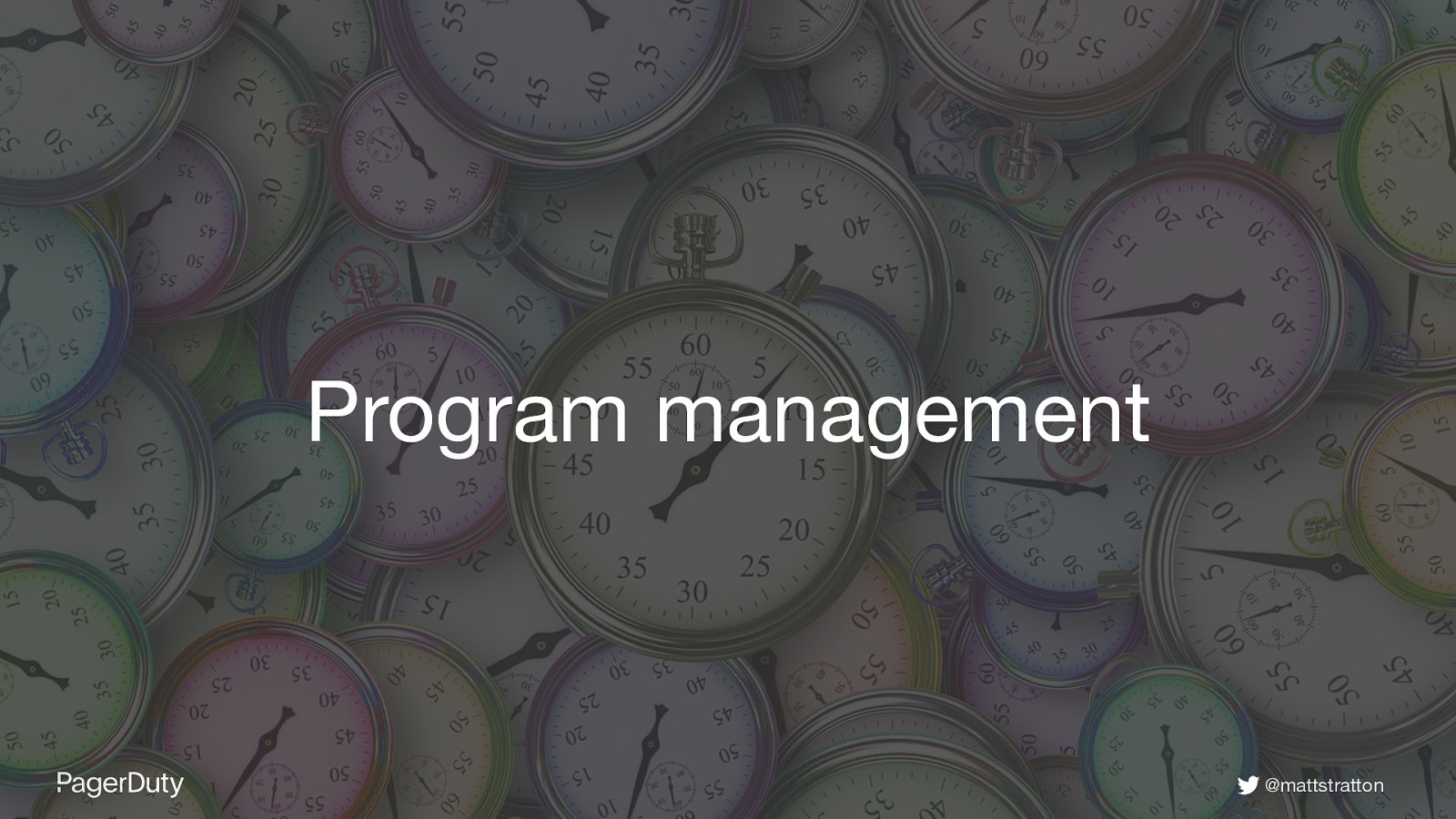
Program management @mattstratton

Responsibilities of program management • Defining what ‘done’ is • Emotional awareness of stress of the rest of the team • Connective tissue work between different teams and features (help understand and mitigate dependencies) • Awareness of what it means to pull people away from other projects to solve a problem @mattstratton

Product owner @mattstratton
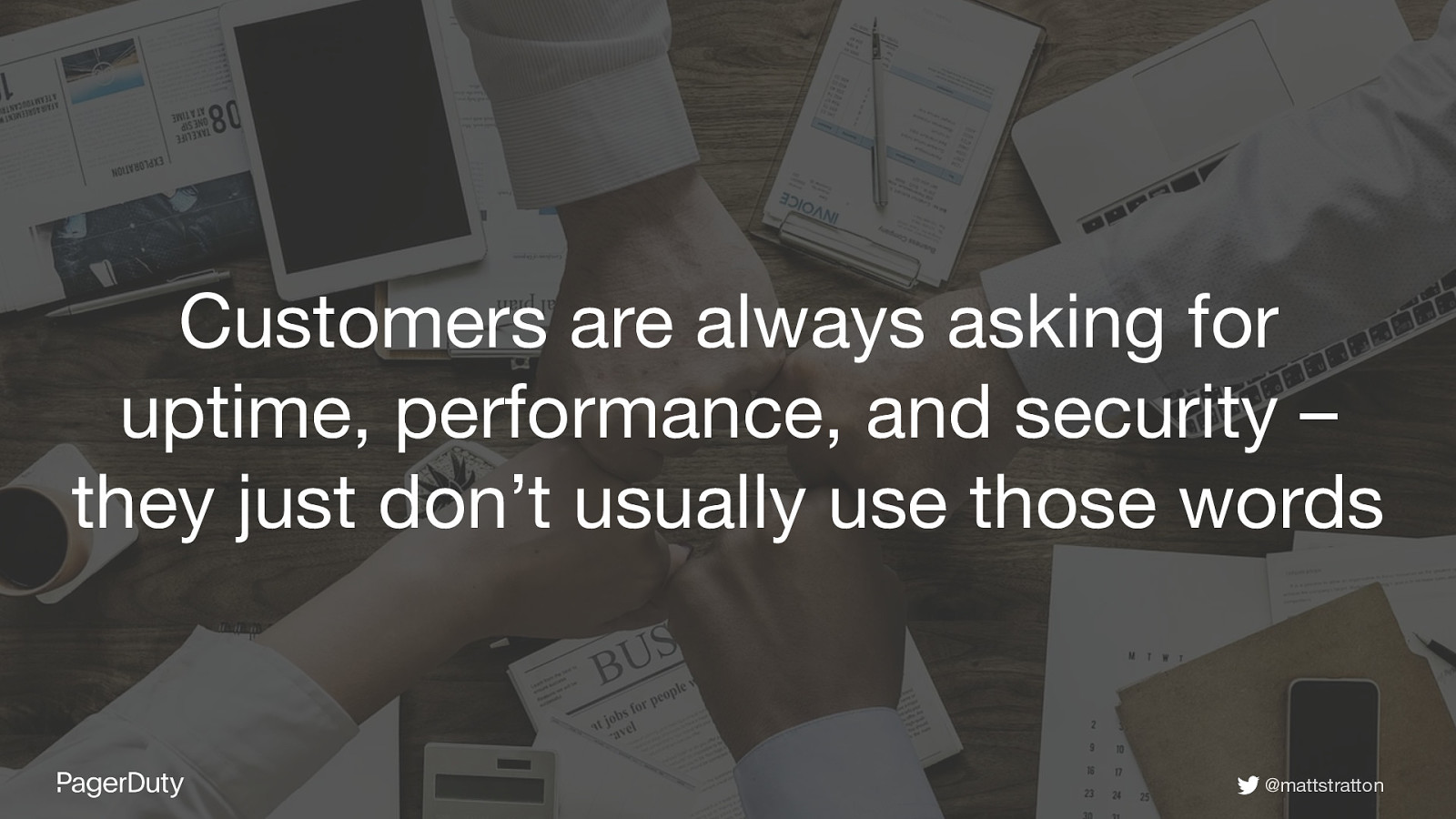
Customers are always asking for uptime, performance, and security – they just don’t usually use those words @mattstratton

Management @mattstratton

• Make room in the roadmap for investing in tech debt • Encourage a culture of cooperation and sharing • Set goals that balance business priorities with achievable engineering goals @mattstratton

Going deeper @mattstratton
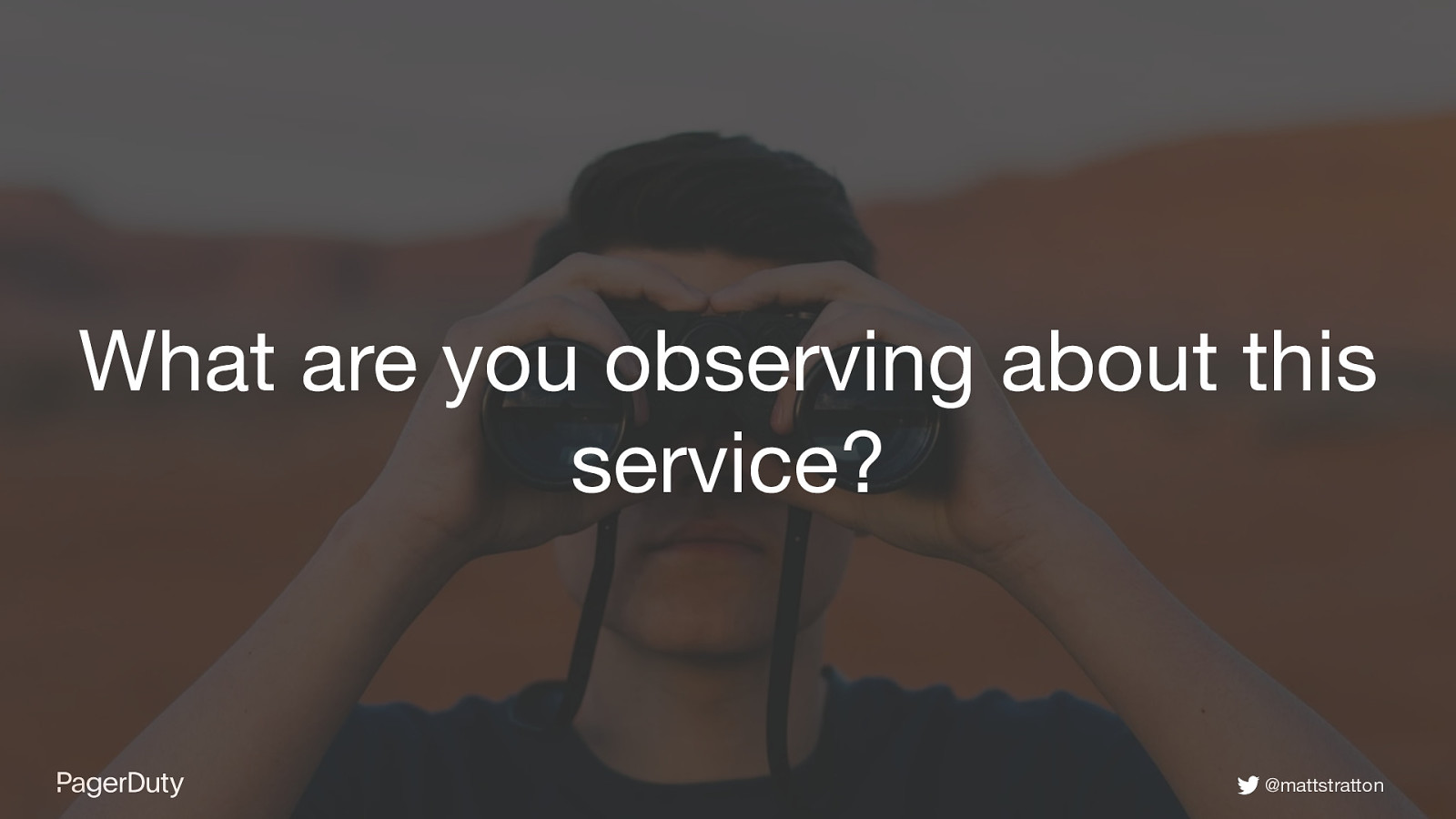
What are you observing about this service? @mattstratton
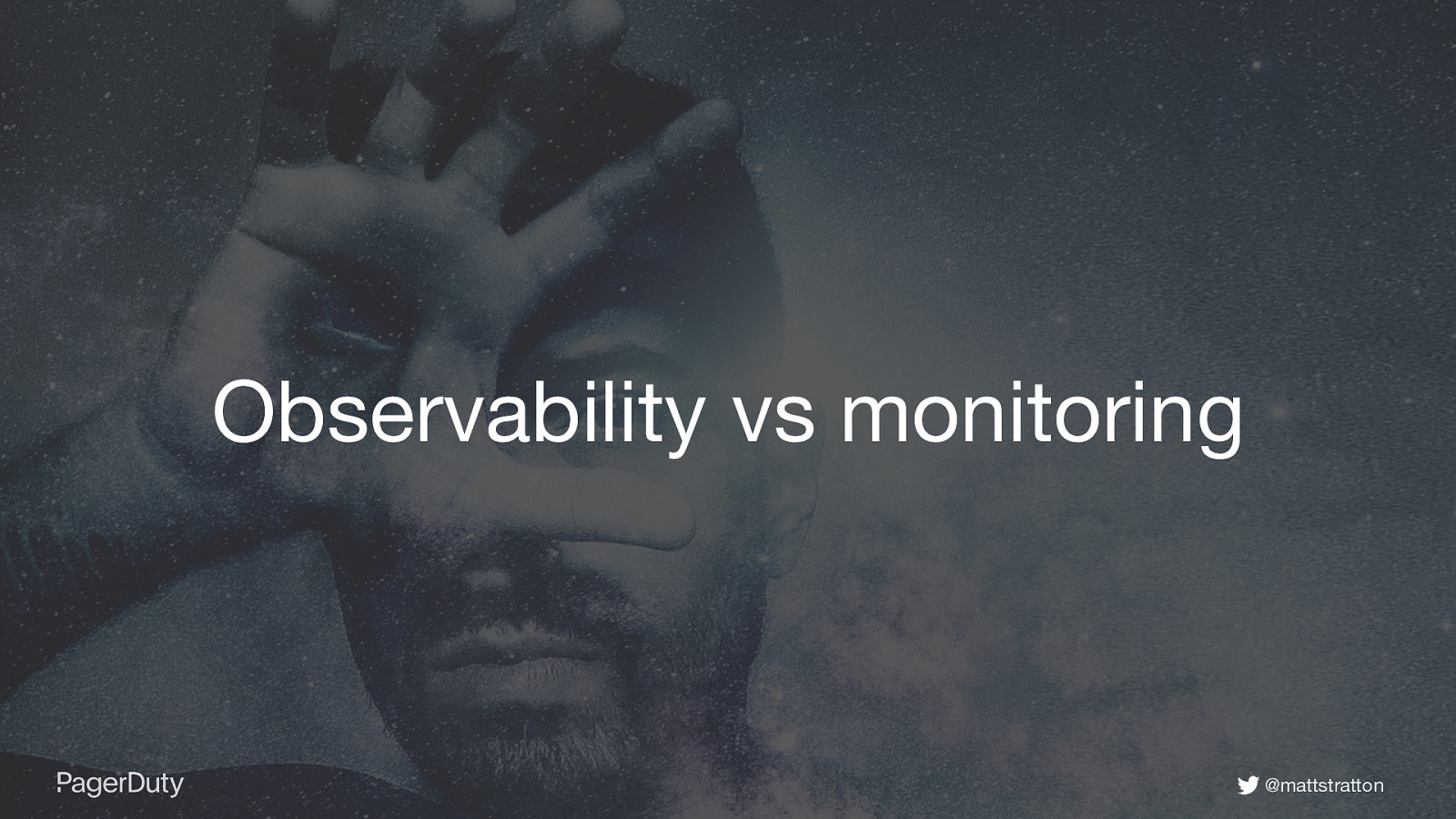
Observability vs monitoring @mattstratton
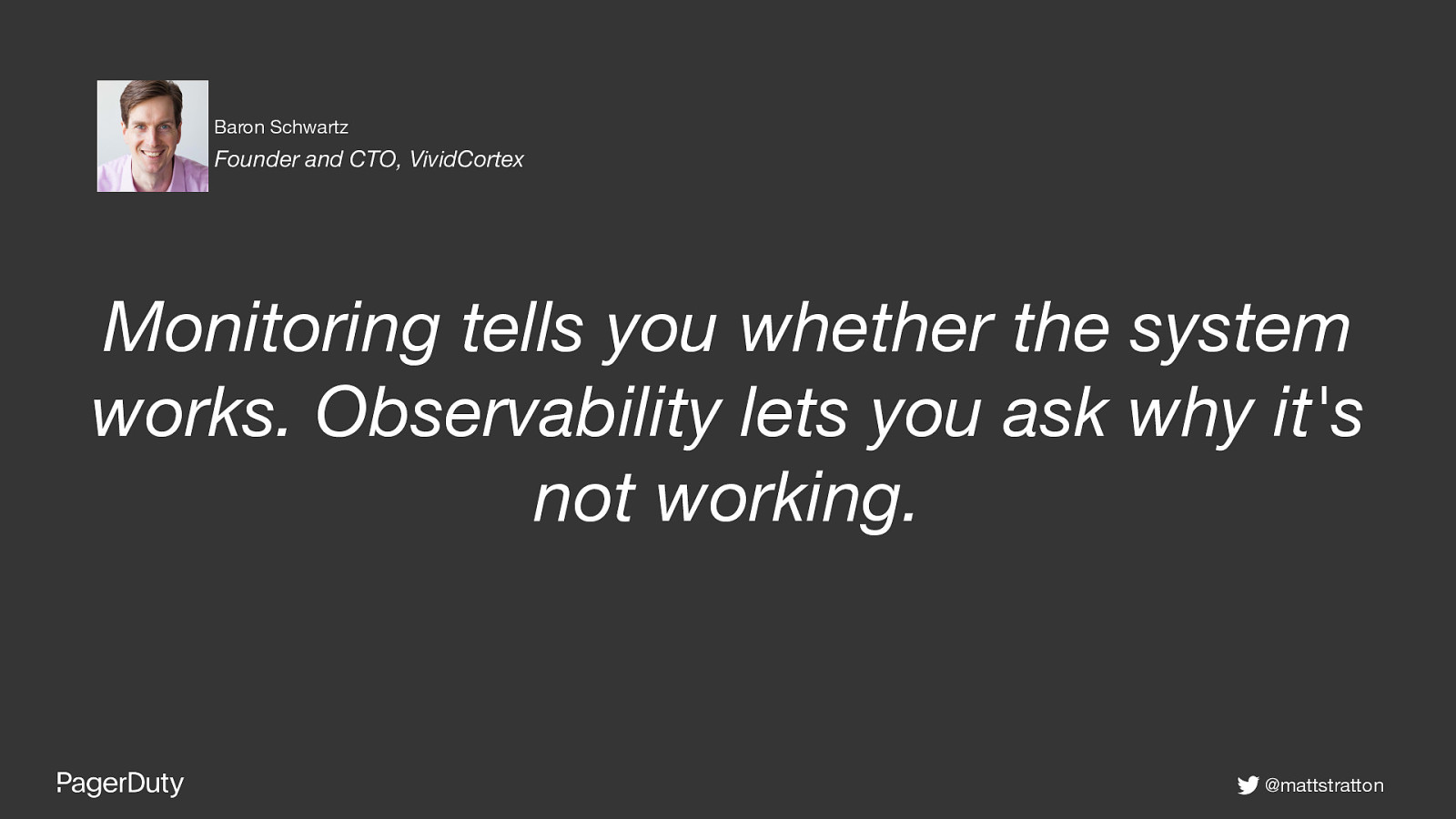
Baron Schwartz Founder and CTO, VividCortex Monitoring tells you whether the system works. Observability lets you ask why it’s not working. @mattstratton

Empathy-driven alerting @mattstratton

A brief overview of SLA/SLO/SLI @mattstratton

Service Level Indicators (SLI) • Latency • Throughput • Availability @mattstratton

Service Level Objectives • Made up of SLI’s • Measured over time • Not contractually set @mattstratton

Service Level Agreements • Composed of SLO’s • Contractually/legally binding • Basically, this is where you owe your customer money @mattstratton

The “hadness” point @mattstratton

Alert on SLO’s @mattstratton
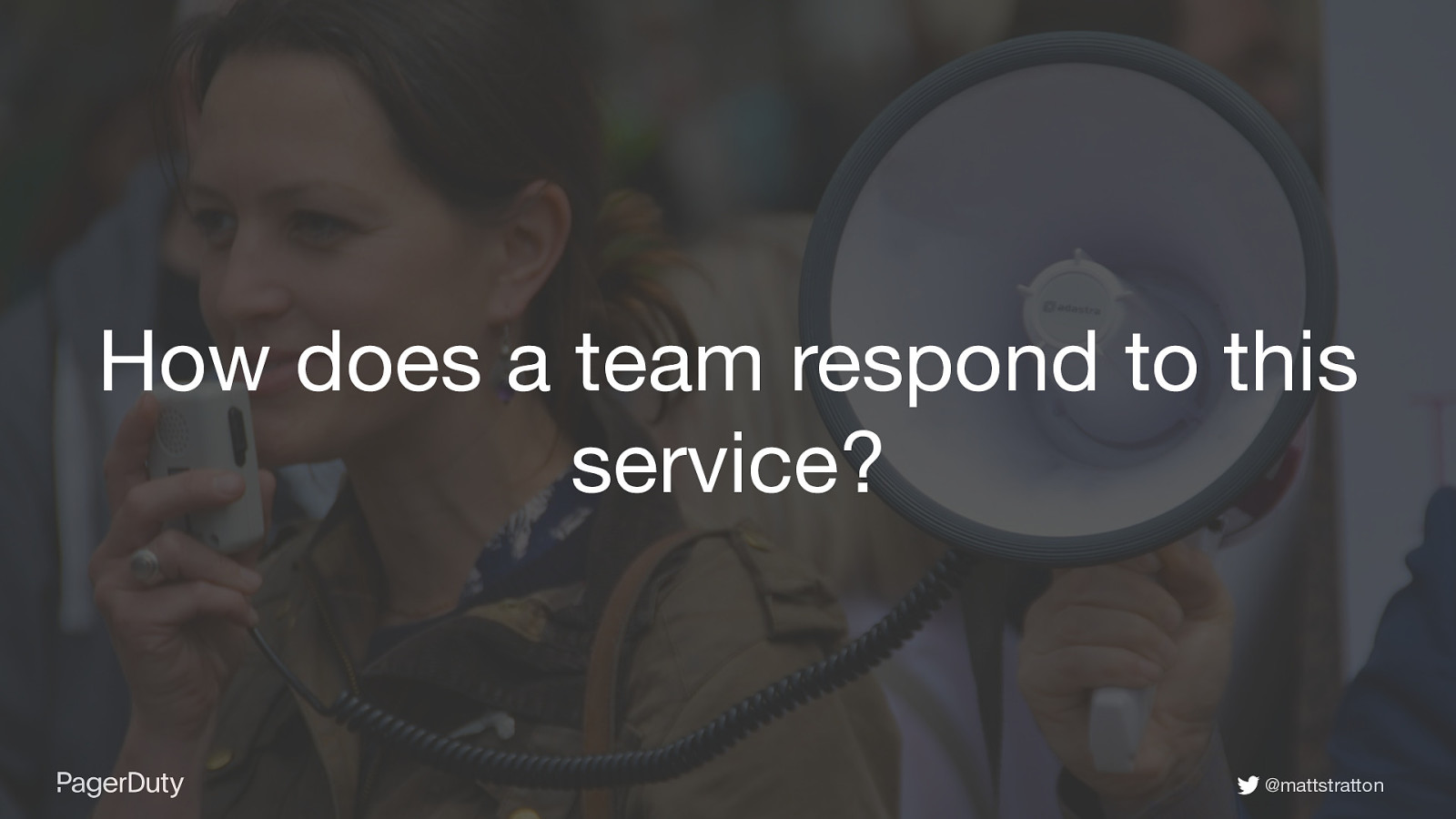
How does a team respond to this service? @mattstratton
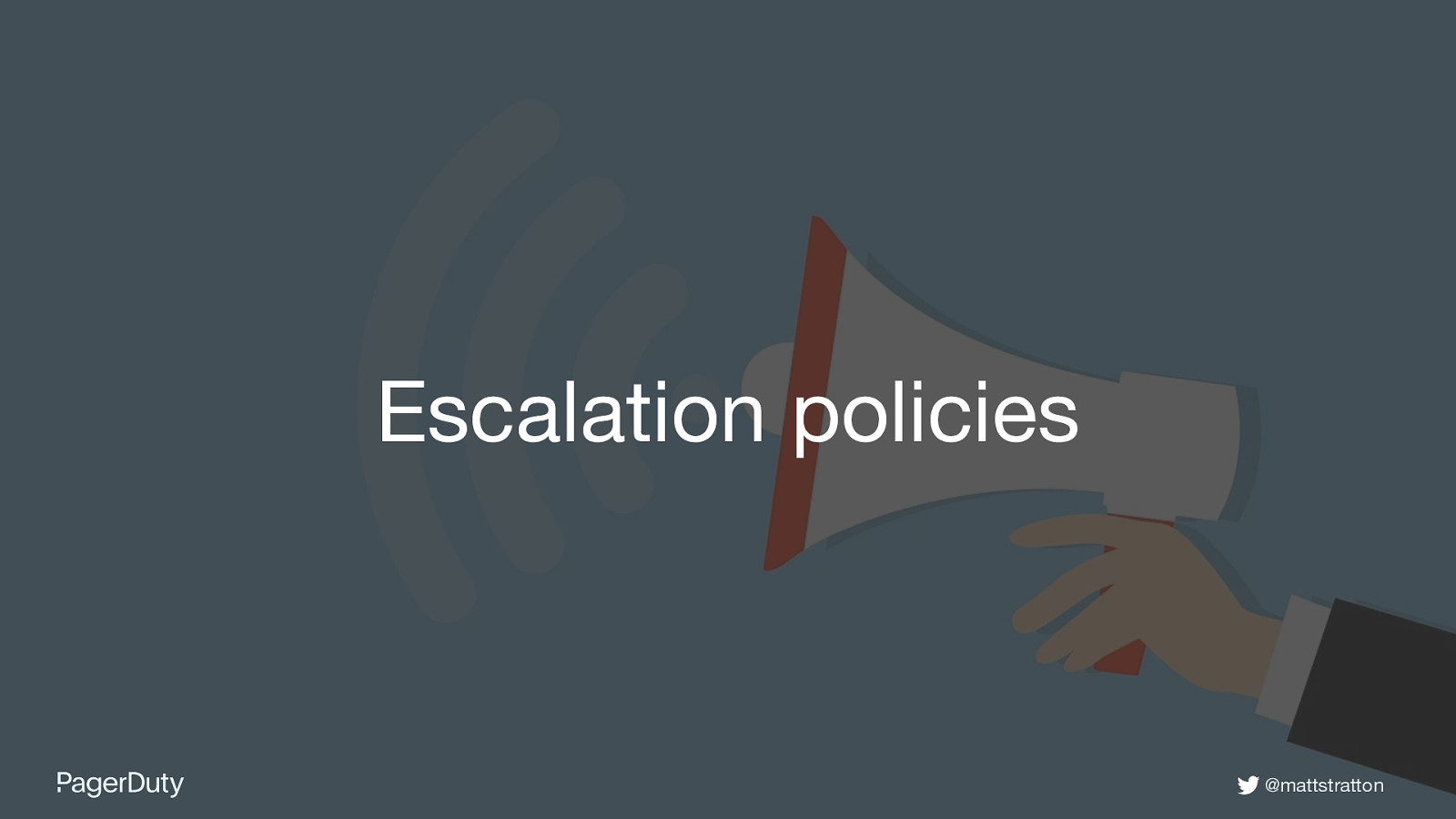
Escalation policies @mattstratton
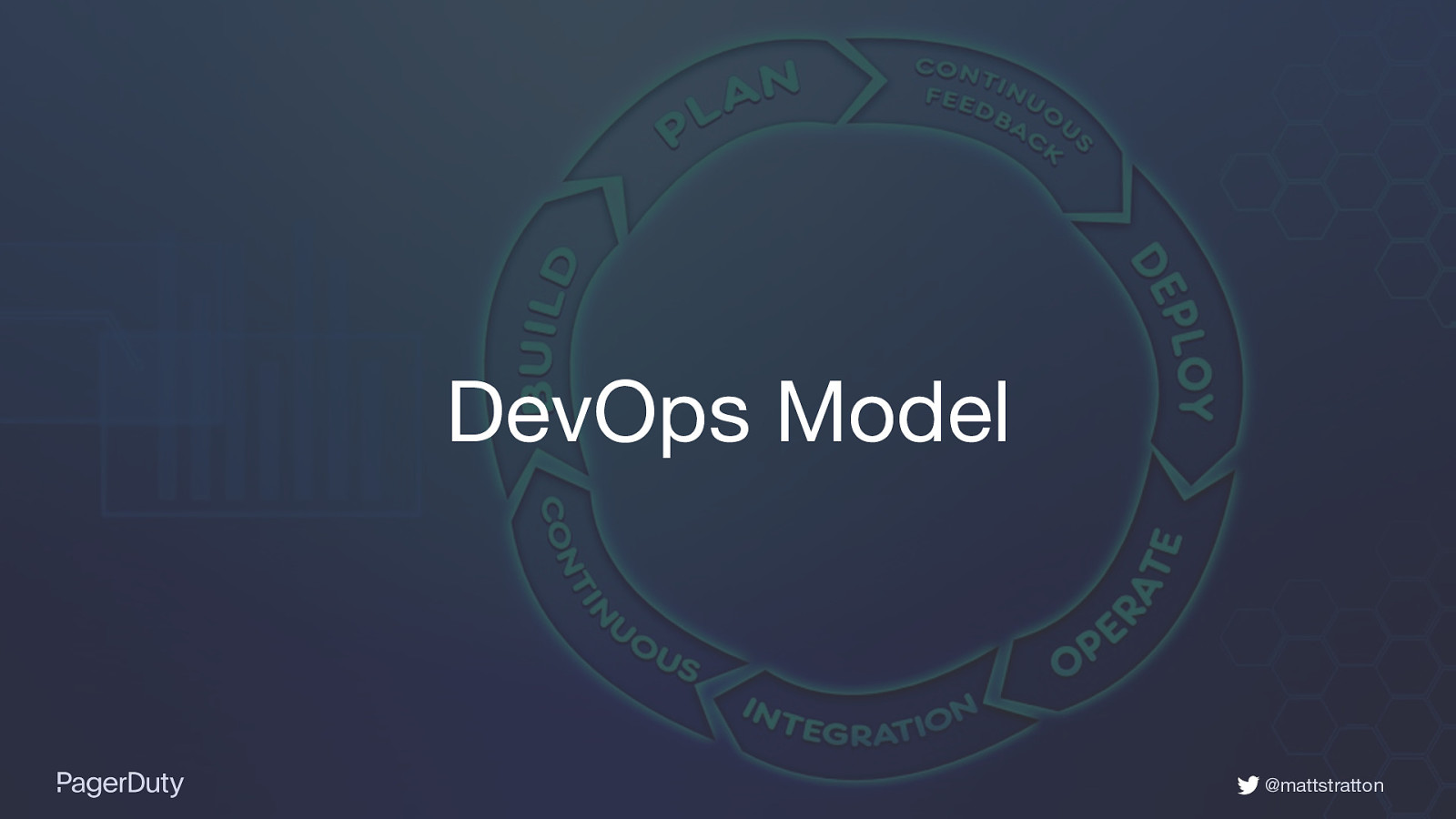
DevOps Model @mattstratton

First level @mattstratton

Second level @mattstratton

Third level @mattstratton

Escalating @mattstratton

Manual escalations @mattstratton

Other escalation models • Central Ops • Hybrid Ops @mattstratton

Tuning your service @mattstratton

Investigate patterns @mattstratton

What alerts do you actually need? @mattstratton
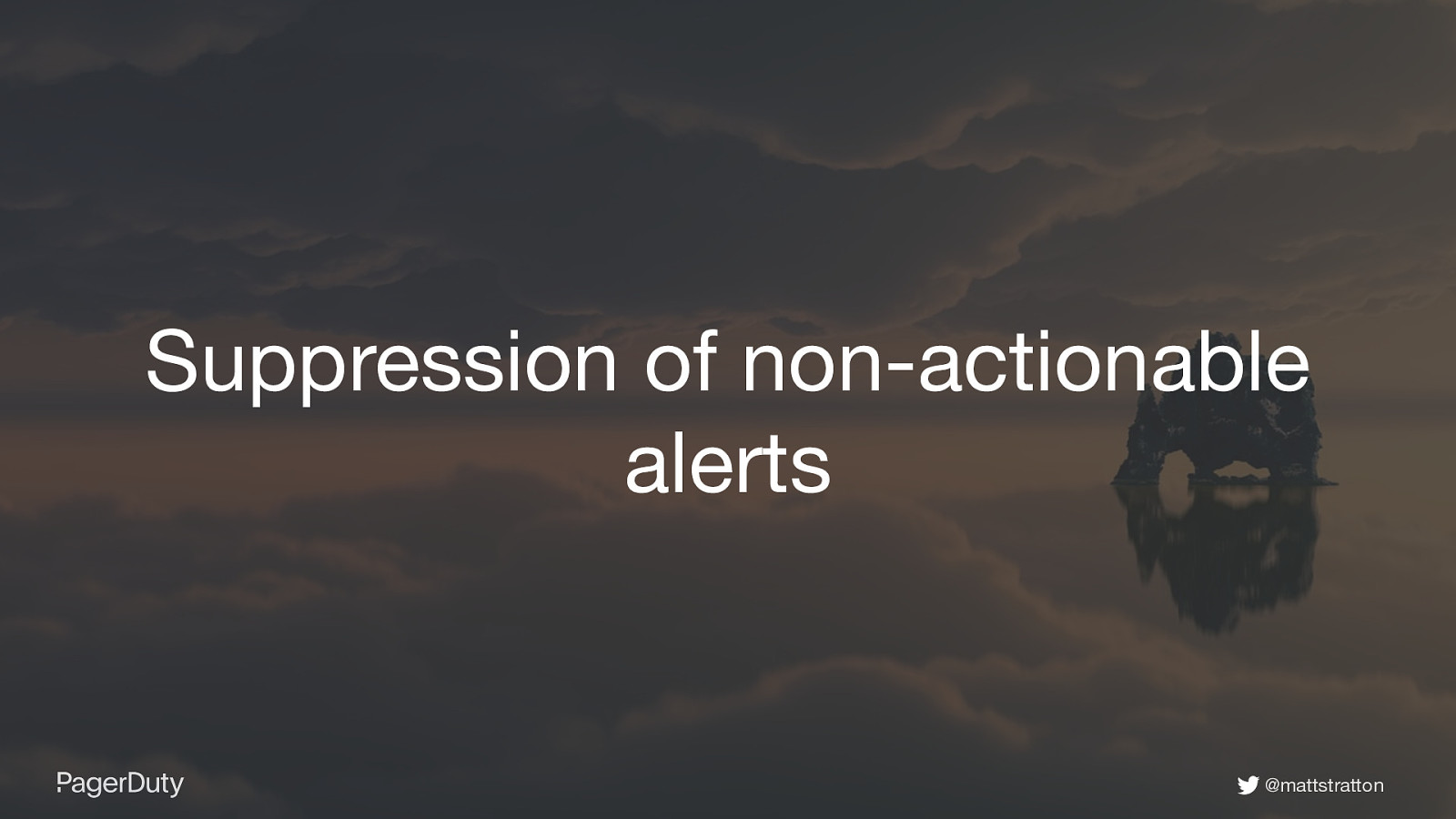
Suppression of non-actionable alerts @mattstratton

Understand business impact @mattstratton

Lifecycle steps @mattstratton

Designing a new service @mattstratton

• Understand the customers (product is a key role here) • Load testing / staging • Ensure SRE / sustainability teams are involved early • Define SLI/SLO/SLA • Identify alerting requirements • Documentation (API, runbook, functional service registry if applicable) • Perform all security checks @mattstratton
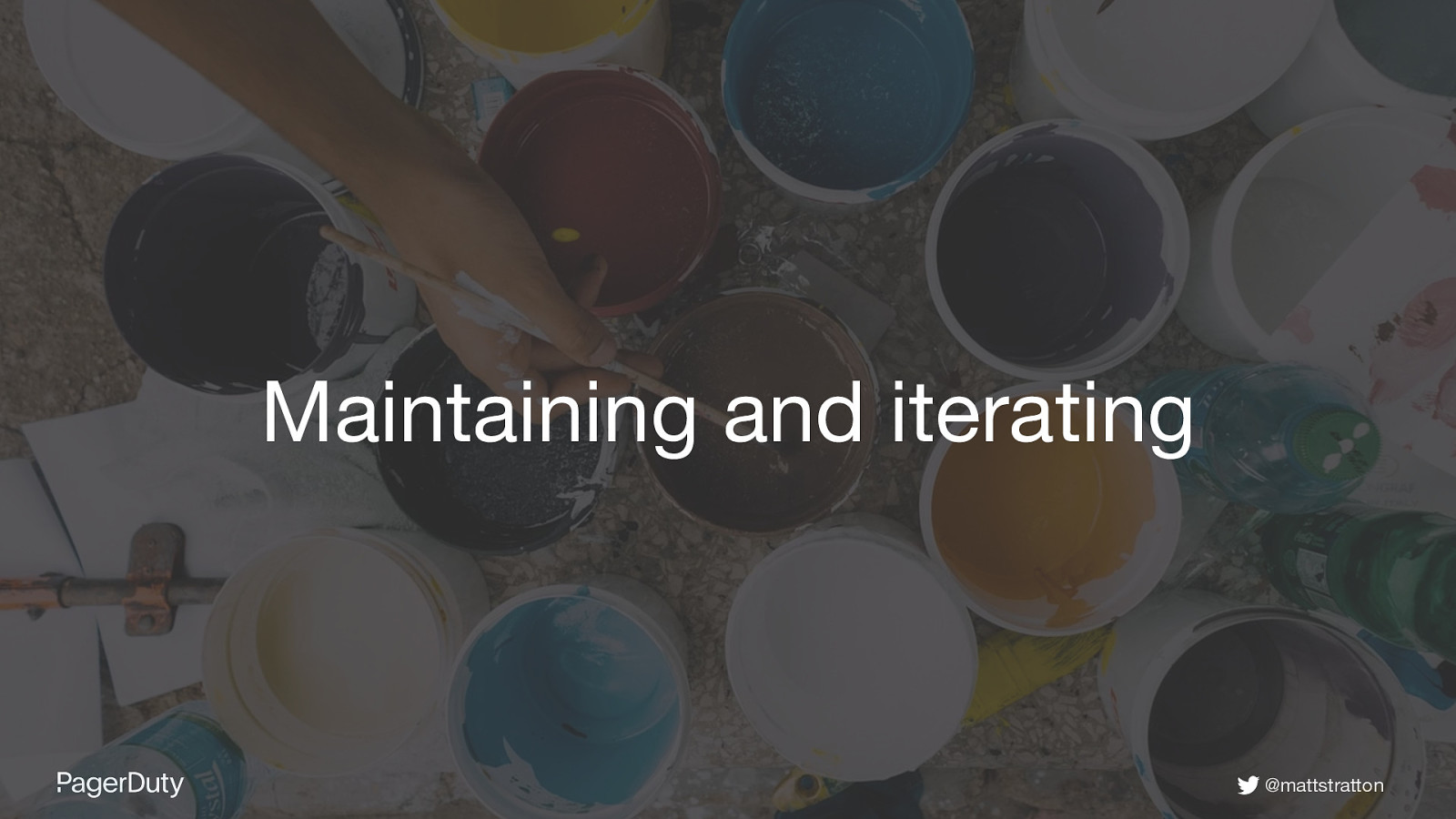
Maintaining and iterating @mattstratton

• Version the service API • Communicate to consumers • Proactive maintenance • Address tech debt consistently • Testing and deploying/releasing the service (CI/CD, testing in prod, etc) @mattstratton

Retiring a service @mattstratton

• Identify consumers • Determine business impact of retiring • Communicate / offboard consumers @mattstratton
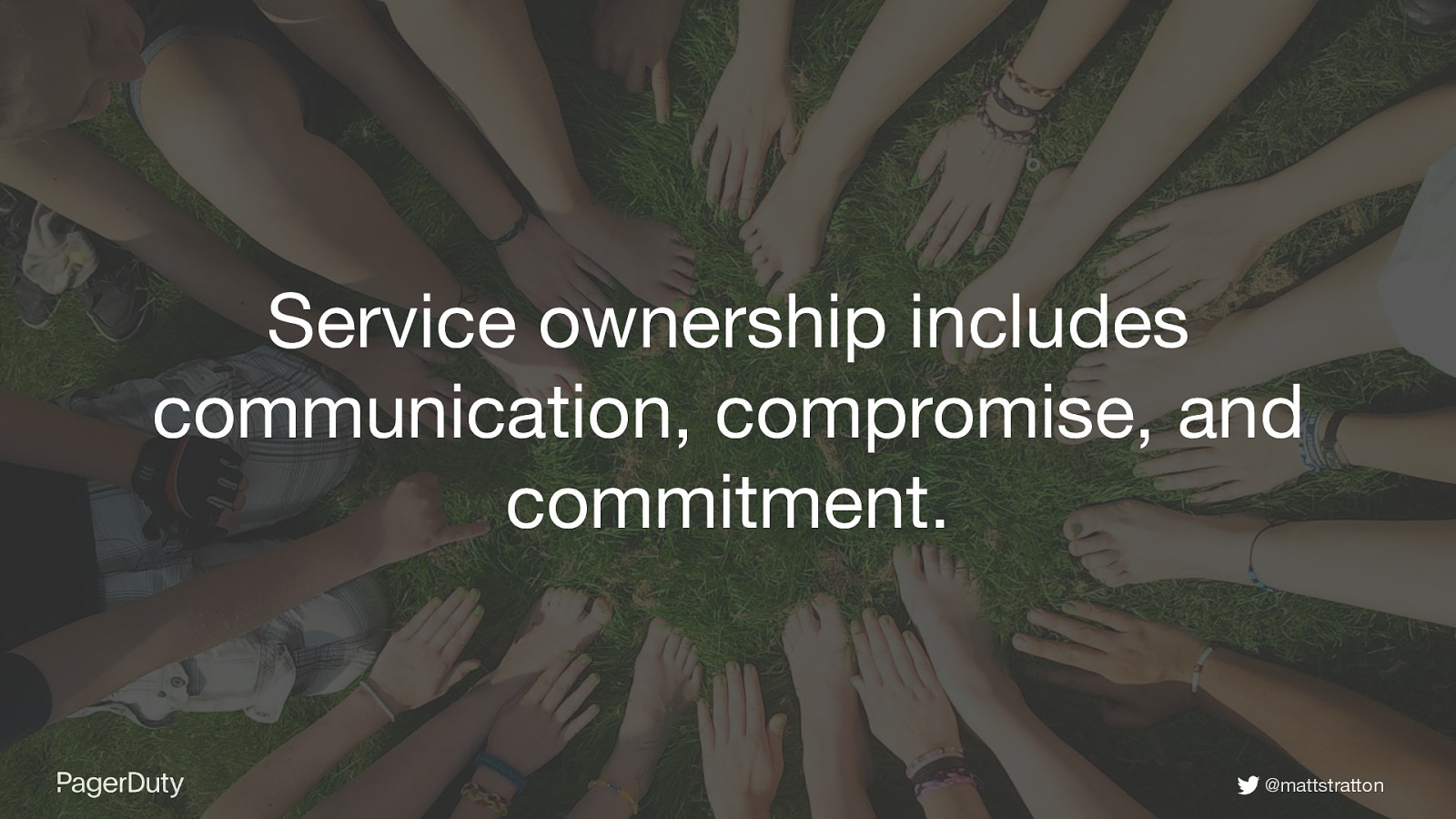
Service ownership includes communication, compromise, and commitment. @mattstratton
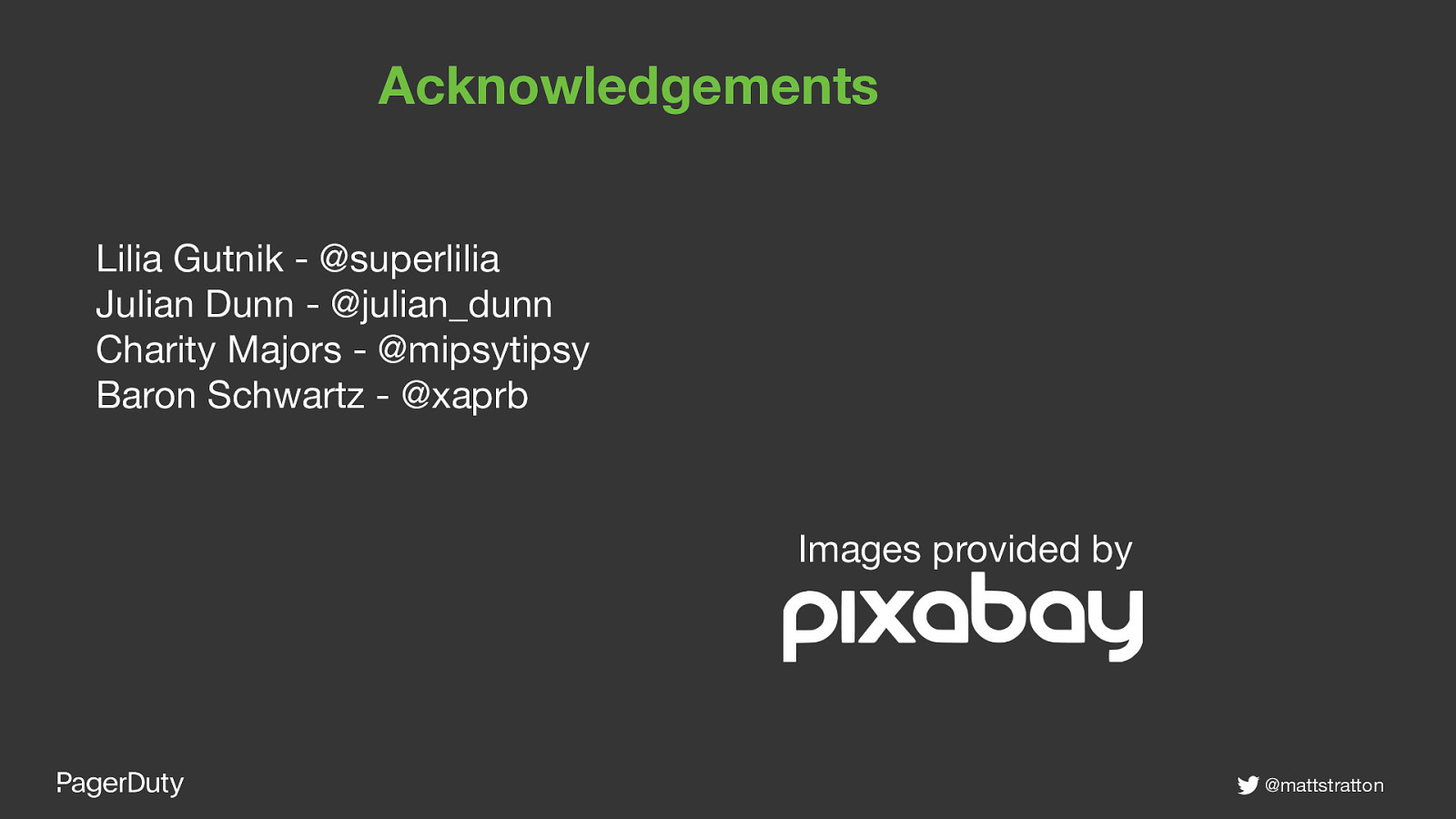
Acknowledgements Lilia Gutnik - @superlilia Julian Dunn - @julian_dunn Charity Majors - @mipsytipsy Baron Schwartz - @xaprb Images provided by @mattstratton
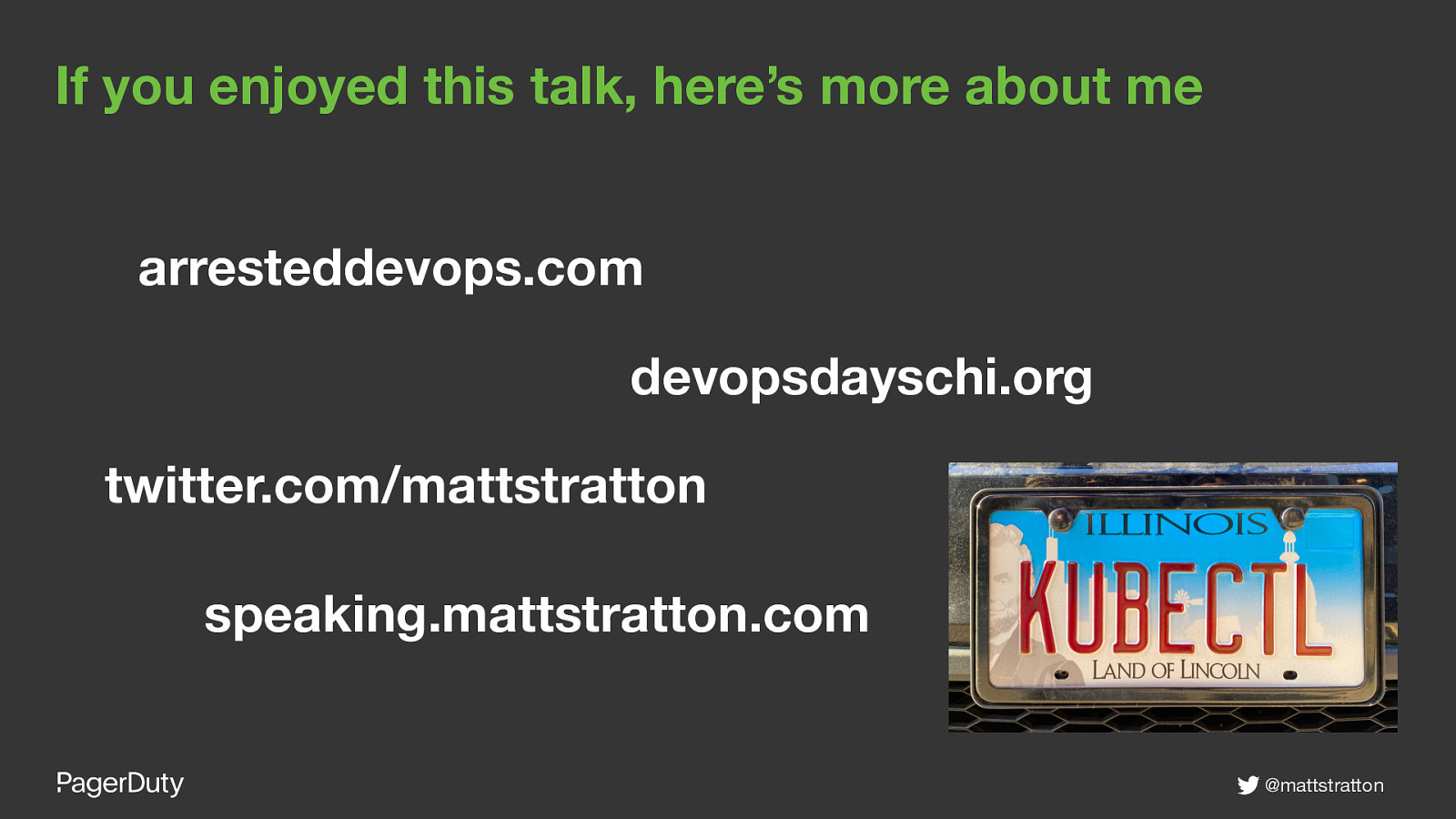
If you enjoyed this talk, here’s more about me arresteddevops.com devopsdayschi.org twitter.com/mattstratton speaking.mattstratton.com @mattstratton
Services are the backbone of our systems. They are the pieces that make up our businesses—whether they are literal microservices or functional components of a traditional application, we can’t do the computer thing without services.
When it comes to a service in your organization, who’s responsible for it? The cast of characters involved in the lifecycle of a service is more than just software engineers. It can include program managers, product owners, sustainability teams (SREs/operations engineers), and business stakeholders, to name a few. We’ll talk about managing a service in production and understanding how that process affects your organization.
Video
Buzz and feedback
Here’s what was said about this presentation on social media.
-
Naming things matters (that, and cache invalidation)! @mattstratton #devopsmsp pic.twitter.com/ySRf0AN13U
— Bridget Kromhout (@bridgetkromhout) January 15, 2020 -
“You actually want both of these things, and these things are not the same.” @mattstratton #devopsmsp pic.twitter.com/0JYJ4s4h5o
— Bridget Kromhout (@bridgetkromhout) January 15, 2020 -
Services aren't just microservices!@mattstratton
— Jenn (@geekgalgroks) January 15, 2020
[Gif: Minon saying "WHAT?!!"] pic.twitter.com/mSbfotzbbJ -
Naming!
— Jenn (@geekgalgroks) January 15, 2020
Don't use inside jokes. Explaining it over and over gets boring. Also can be problematic.@mattstratton -
“Address tech debt consistently.” Yes please! @mattstratton on the lifecycle of a service #devopsmsp
— Jenna Pederson (@jennapederson) January 15, 2020 -
I missed this question but the answer is:
— Jenn (@geekgalgroks) January 15, 2020
Invent a time a machine and document that shit.@mattstratton -
The "hadness" point
— Jenn (@geekgalgroks) January 15, 2020
The point where customers go from happy to sad. This is where the SLO should be set.
Alert on SLO not SLA.@mattstratton
[Gif: Man in a hat saying, "Alert! Alert!"] pic.twitter.com/NS3SJTRqzn
